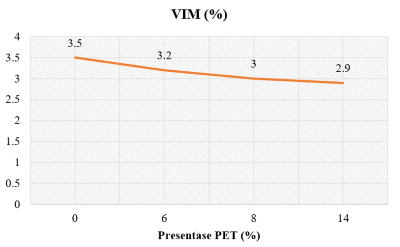Utilization of PET Plastic Waste in Concrete Asphalt Mixture (AC-BC) to Improve the Stability and Sustainability of Road Infrastructure
DOI:
https://doi.org/10.24036/cived.v12i1.714Keywords:
AC-BC, Road Pavement, Volumetric, Waste PETAbstract
Plastic waste, especially Polyethylene Terephthalate (PET), is one of the biggest environmental issues in Kediri City, with a volume of 140 tons per month. This research aims to utilize PET plastic waste as an additional material in the Asphalt Concrete-Binder Course (AC-BC) mixture. The study was conducted using an experimental method with variations in PET levels of 0%, 6%, 8%, and 14% of the total weight of the mixture. The test was carried out using Marshall standards to evaluate performance parameters such as stability, flow, VIM (Void in Mix), VMA (Void in Mineral Aggregate), and VFB (Void Filled with Bitumen). The results showed that the addition of PET to 6% increased the stability of the mixture to 6300 kg, higher than the mixture without PET (6200 kg). The flow value increased with the addition of PET, reaching 3.8 mm at a rate of 14%. In addition, VMA and VIM tend to decrease, indicating an increase in the density of the mixture, while VFB achieves an optimal value at a PET level of 6%. This study concluded that PET waste can be used effectively to improve the performance of AC-BC mixtures, with an optimal level of 6%. The utilization of PET plastic waste not only improves the performance of road infrastructure but also contributes to the reduction of plastic waste, thus supporting environmentally friendly and sustainable construction solutions.
Downloads
References
R. Kediri, “Harmoni Kediri The Service City _ Radar Kediri.” 2020.
A. K. Kurnia et al., “Pengaruh Material Lokal Kediri Terhadap Tingkat Durabilitas Lapis Struktur Jalan,” J. Ris. Rekayasa Sipil, vol. 7, no. 1, pp. 1–7, 2023.
A. Ameli, J. Maher, A. Mosavi, N. Nabipour, R. Babagoli, and N. Norouzi, “Performance evaluation of binders and Stone Matrix Asphalt (SMA) mixtures modified by Ground Tire Rubber (GTR), waste Polyethylene Terephthalate (PET) and Anti Stripping Agents (ASAs),” Constr. Build. Mater., vol. 251, p. 118932, 2020, doi: 10.1016/j.conbuildmat.2020.118932.
G. M. Alemu, D. T. Melese, T. W. Mahdi, and A. B. Negesa, “Combined Performance of Polyethylene Terephthalate Waste Plastic Polymer and Crumb Rubber in Modifying Properties of Hot Mix Asphalt,” Adv. Mater. Sci. Eng., vol. 2023, 2023, doi: 10.1155/2023/6320490.
S. Haider, I. Hafeez, Jamal, and R. Ullah, “Sustainable use of waste plastic modifiers to strengthen the adhesion properties of asphalt mixtures,” Constr. Build. Mater., vol. 235, p. 117496, 2020, doi: 10.1016/j.conbuildmat.2019.117496.
M. Induwati et al., “Identifikasi Karakteristik Agregat Terhadap Nilai Stabilitas Lapis Perkerasan Aspal Beton AC-BC ( Laston ) berkualitas maka perlu diberikan teknologi penanganan yang bernilai ekonomis menurun . Turunnya nilai stabilitas tersebut disebabkan oleh air yang m,” Teras J., vol. 13, no. 1, pp. 193–206, 2023.
A. Wahyu et al., “IDENTIFICATION OF THE SOIL CHARACTERISTICS OF THE,” vol. 22, no. 1, pp. 72–80, 2023.
N. Fahrriana, Y. Ismina, E. N. Lydia, and H. Ariesta, “Analisis Klasifikasi Tanah Dengan Metode Uscs ( Meurandeh Kota Langsa ),” J. Ilm. Jurutera, vol. 6 (2), pp. 005–013, 2019, [Online]. Available: https://ejurnalunsam.id/index.php/jurutera/article/view/1622/1284.
L. Juniantoro et al., “Cara Mudah Menentukan Material Terbaik dalam Struktur Jalan Menggunakan Metode Marshall Test,” JMTS J. Mitra Tek. Sipil, vol. 6, no. 2, pp. 309–320, 2023.
A. Verdiawan et al., “Optimalisasi Stabilitas Pada Lapis Aspal Beton Dengan Menggunakan Agregat Limbah Beton,” Racic Rab Constr. Res., vol. 8, no. 2, pp. 194–205, 2023, doi: 10.36341/racic.v8i2.3200.
A. T. Purnomo, A. D. Cahyono, D. Widyatmoko, and M. N. Al Hasbi, “Peningkatan Stabilitas Aspal Dalam Konstruksi Jalan : Pengaruh Komposisi, Faktor Lingkungan, Dan Metode Pengujian Untuk Keberlanjutan Infrastruktur Jalan,” Techno (Jurnal Fak. Tek. Univ. Muhammadiyah Purwokerto), vol. 25, no. 1, p. 29, 2024, doi: 10.30595/techno.v25i1.17662.

Downloads
Published
How to Cite
Issue
Section
License
Copyright (c) 2025 Andri Dwi Cahyono, Zendy Bima Mahardana, Evita Fitrianis Hidiyati, M. Faisol Firmansyah, Erwindsyah Putra W

This work is licensed under a Creative Commons Attribution 4.0 International License.







2.jpg)
